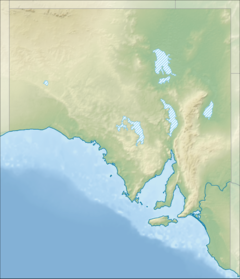Mount Remarkable National Park
| Mount Remarkable National Park | ||
|---|---|---|
| View from the slope of Mount Remarkable | ||
|
|
||
| Location: | South Australia , Australia | |
| Specialty: | Eucalyptus forest | |
| Surface: | 106 km² | |
| Founding: | 1952 | |
The Mount Remarkable National Park (English: Mount Remarkable National Park ) is a national park in the Australian state of South Australia , which is about 240 km north of Adelaide .
Partial areas were placed under protection as early as 1952; the park has been repeatedly enlarged and now covers around 106 km².
General
The park gives visitors the impression of real wilderness, but is still easily accessible from Adelaide and the more densely populated areas of South Australia. It extends from the coastal plains to the foothills of the Flinders range near Wilmington . Since the arid and more humid regions of the country overlap here, one can find a community of animals and plants of both landscape types.
Flora
Large parts of the area are covered with eucalyptus forests and mallee . Characteristic tree species are the sugar gum ( Eucalyptus cladocalyx ), white gum eucalyptus ( Eucalyptus leucoxylon ) and peppermint box ( Eucalyptus odorata ). The ornamental cypresses ( Callitris columellaris ) and various acacias can also be found in the lower forests . Magnificent specimens of the red eucalyptus ( Eucalyptus camaldulensis ) line the waters of the park. In spring, flowering plants such as hill silkworm ( Alyogyne huegelii ), the golden acacia and the orchid species Thelymitra nuda catch the eye.
Wildlife
Both the mountain kangaroo and the western gray giant kangaroo are native to the entire park, while the red giant kangaroo can only be seen in certain areas, such as in the lower-lying areas. Especially in spring, visitors come across ant urchins .
The national park is of particular importance for the conservation of the yellow-footed rock kangaroo . This species has been hunted almost to extinction. After the hunt ceased, capture by foxes and other predators prevented the species from recovering. A protection program for the yellow-footed rock kangaroo is therefore an important part of national park management.
Due to the diverse landscape, the area also has a rich bird life. More than 117 native bird species have been identified so far. One of the most striking is the wedge-tailed eagle , which can be seen in most habitats. Other notable bird species include the ringed parakeet , pink cockatoo , blue-breasted easel tail, and kookaburra and emus .
Web links
Footnotes
- ↑ Information from the government of South Australia on the history of the park ( Memento of the original from January 27, 2010 in the Internet Archive ) Info: The archive link has been inserted automatically and has not yet been checked. Please check the original and archive link according to the instructions and then remove this notice.
- ↑ General information from the government of South Australia ( Memento of the original from October 15, 2009 in the Internet Archive ) Info: The archive link was automatically inserted and not yet checked. Please check the original and archive link according to the instructions and then remove this notice.
- ↑ a b c Information on flora and fauna ( memento of the original from January 27, 2010 in the Internet Archive ) Info: The archive link has been inserted automatically and has not yet been checked. Please check the original and archive link according to the instructions and then remove this notice.

